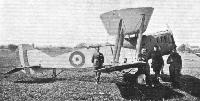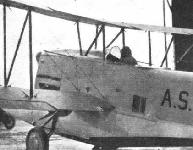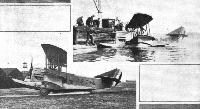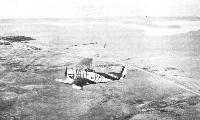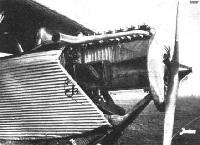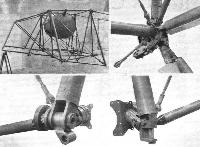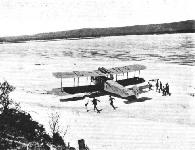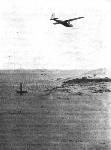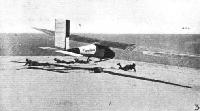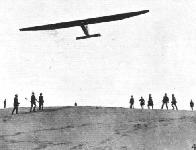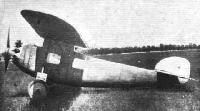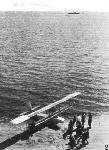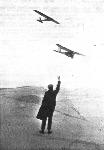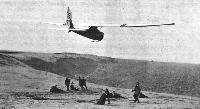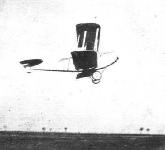Фотографии
-
Two views of the "Aero-Sport I," a dual-control school machine with 120 h.p. Mercedes engine.
Самолёты на фотографии: LVG B.I / B.II / B.III - Германия - 1914
-
The Junkers K.16 is a small cabin monoplane with accommodation for two passengers. The engine is a Siemens.
Самолёты на фотографии: Junkers K 16 - Германия - 1921
-
The Focke-Wulf A.16 is, perhaps, one of the most efficient German commercial aeroplanes. It is fitted with a Siemens 75 h.p. engine.
Самолёты на фотографии: Focke-Wulf A.16 - Германия - 1924
-
A development of the type A.16 is the Focke-Wulf A.16a, which has a 100 h.p. Mercedes engine. Yet another development is the A.16b, which is fitted with a Junkers L.Ia engine of 78 h.p.
Самолёты на фотографии: Focke-Wulf A.16 - Германия - 1924
-
BRISTOLS FOR GREECE: One of a series of "Bristol" Advanced Training Machines recently supplied to the Greek Naval Air Service. Standing near the engine will be seen (left to right) Engineer-Lieut. Alifantis, Mr. C. F. Uwins (chief Bristol pilot) and Lieut.-Commander Retsinopoulo.
Самолёты на фотографии: Bristol F.2A/F.2B Fighter - Великобритания - 1916
-
A "close-up" of the Loening Model 34 Amphibian, showing the position of the pilot and the retracting undercarriage.
Самолёты на фотографии: Loening OL / OA - США - 1923
-
THE LOENING MODEL 34 AMPHIBIAN: Two views of the machine, showing it on the water with wheels up, and on land with wheels down.
Самолёты на фотографии: Loening OL / OA - США - 1923
-
THE LOENING AMPHIBIAN: View, showing the machine flying over Langley Field, Virg. The tractor-fuselage type of biplane and the flying boat are, it will be seen, ingeniously blended together to form a new type. It is fitted with a 400 h.p. inverted Liberty engine.
Самолёты на фотографии: Loening OL / OA - США - 1923
-
Loening Model 34 Amphibian 400 hp. Inverted "Liberty" Engine
Самолёты на фотографии: Loening OL / OA - США - 1923
-
The Junkers T.26 is an all-Duralumin parasol monoplane with Junkers engine.
Самолёты на фотографии: Junkers T 21 / Ю-21 / J 22 / T 26 - Германия - 1923
-
The Junkers L.I air-cooled engine as installed in the Junkers T.26 aeroplane.
Самолёты на фотографии: Junkers T 21 / Ю-21 / J 22 / T 26 - Германия - 1923
-
The Udet U.7 ("Kolibri") has a British Douglas engine.
Самолёты на фотографии: Udet U-7 Kolibri - Германия - 1924
-
"Kolibri" U 7
Самолёты на фотографии: Udet U-7 Kolibri - Германия - 1924
-
The Udet U.12 ("Flamingo") is believed to be the first biplane built by the Udet firm. The engine is a Siemens.
Самолёты на фотографии: Udet U-12 Flamingo - Германия - 1925
-
Регистрационный номер: G-EBKF [3] The Blackburn "Dart" Seaplane: The machine just leaving the slipway, the wheels not yet having been raised.
Самолёты на фотографии: Blackburn Swift T.1 / Dart T.2 - Великобритания - 1920
-
THE BLACKBURN "DART" SEAPLANE: Some constructional features. In the upper left-hand corner is a view of the steel tube centre portion of the fuselage. Note the system of triangulation, and the main petrol tank. The other photographs show typical fittings, machined from the solid.
Самолёты на фотографии: Blackburn Swift T.1 / Dart T.2 - Великобритания - 1920
-
Регистрационный номер: G-EBKF [3] The Blackburn "Dart" Seaplane: Front view of the machine at the top of the slipway.
Самолёты на фотографии: Blackburn Swift T.1 / Dart T.2 - Великобритания - 1920
-
THE BLACKBURN "DART" SEAPLANE: The sprung skid on the heel of a float.
Самолёты на фотографии: Blackburn Swift T.1 / Dart T.2 - Великобритания - 1920
-
Регистрационный номер: G-EBKF [3] THE BLACKBURN "DART" SEAPLANE: The tail, with balanced rudder and elevator.
Самолёты на фотографии: Blackburn Swift T.1 / Dart T.2 - Великобритания - 1920
-
THE BLACKBURN "DART" SEAPLANE: The trolley, and its framework. This trolley is raised clear of the water as soon as the machine is afloat.
Самолёты на фотографии: Blackburn Swift T.1 / Dart T.2 - Великобритания - 1920
-
THE BLACKBURN "DART" SEAPLANE: Three views of the engine housing, engine mounting, and complete nose. The engine is a Napier "Lion."
Самолёты на фотографии: Blackburn Swift T.1 / Dart T.2 - Великобритания - 1920
-
THE BLACKBURN "DART" SEAPLANE: A view into the cockpit, showing control wheel instrument-board, starting magneto, etc.
Самолёты на фотографии: Blackburn Swift T.1 / Dart T.2 - Великобритания - 1920
-
Blackburn "Dart" Seaplane Napier "Lion" Engine
Самолёты на фотографии: Blackburn Swift T.1 / Dart T.2 - Великобритания - 1920
-
The Sikorsky S.29A Commercial Biplane: A twin-engined (400 h.p. "Liberty") transport machine designed and constructed in America by the well-known Russian designer, Igor Sikorsky; it is almost entirely of metal construction.
Самолёты на фотографии: Sikorsky S-29 - США - 1924
-
The Sikorsky S.29A Commercial Biplane: Front view, showing the arrangement of the two "Liberty" engines.
Самолёты на фотографии: Sikorsky S-29 - США - 1924
-
Регистрационный номер: N173 The Fairey "Fremantle": A long-range twin-float seaplane with Rolls-Royce "Condor"engine. This machine carries a crew of five. The main petrol tanks are housed in the floats, which are exceptionally large, giving the machine a cruising range of approximately 1,100 miles. The top speed is about 100 m.p.h. and the cruising speed 80 m.p.h. A feature of the machine is its large wireless cabin, which is situated aft of the pilot's cockpit.
Самолёты на фотографии: Fairey Fremantle - Великобритания - 1924
-
The Heinkel H.D.21: Three-quarter rear view.
Самолёты на фотографии: Heinkel HD.21/22/24/32/35/36 - Германия - 1924
-
Heinkel HD 21 School Machine
Самолёты на фотографии: Heinkel HD.21/22/24/32/35/36 - Германия - 1924
-
Регистрационный номер: G-EARV A Westland Limousine in Canada: But for the Westland Limousine (Napier "Lion'') shown above, the mining village of Rouyn in Canada would be isolated from civilisation during the winter months, for snow and ice renders the roads useless. Westland Limousines, however, maintain a daily in-and-out service between Rouyn and Larder Lake - a distance of about 100 miles - and thus provide the inhabitants with fresh supplies from the "Larder." The machines are fitted with skids in place of wheels, enabling them to function on the ice and snow.
Самолёты на фотографии: Westland Limousine - Великобритания - 1919
-
A two-seater glider at Rossitten: The Academic Flying Group, Darmstadt's "Margarete," in flight over the Kurischen-Haff. Note the kind of country over which the machines fly.
Самолёты на фотографии: Darmstadt D-04 - D-07 - Германия - 1922
-
The German ''Kustenflug, 1925' : This year's competition over the sand dunes surrounding the Kurisches-Haff, in the Baltic, has attracted a fairly large number of gliders and at least one light 'plane. Our photographs show : 3 shows an exciting take-off by the "Espenlaub 5," in which the starting crew had to fall flat to avoid the machine.
Самолёты на фотографии: Espenlaub E.03 - E.05 - Германия - 1922
-
The "Espenlaub 5" is seen in flight. Note the high aspect ratio.
Самолёты на фотографии: Espenlaub E.03 - E.05 - Германия - 1922
-
The Udet U.10 low-wing monoplane is designed for sport flying, and has a Siemens engine.
Самолёты на фотографии: Udet U-6 / U-10 - Германия - 1923
-
U 10
Самолёты на фотографии: Udet U-6 / U-10 - Германия - 1923
-
The Udet U.8 is a commercial monoplane with Siemens engine.
Самолёты на фотографии: Udet U-5 / U-8 - Германия - 1923
-
U 8
Самолёты на фотографии: Udet U-5 / U-8 - Германия - 1923
-
THE BRUSSELS-CONGO FLIGHT: This photograph shows the three-engined Handley Page aeroplane in which Lieut. Thieffry and his companions flew from Brussels to Congo. The central engine is a Rolls-Royce "Eagle IX," while the two wing engines are Siddeley "Pumas." The machine was fully described and illustrated in "FLIGHT" on May 1, 1924. This particular machine was built under licence in Belgium by the S.A.B.C.A. Company.
Самолёты на фотографии: Handley Page Hamilton W.8e/H.P.26 / Hampstead W.9/H.P.27 - Великобритания - 1924
-
Регистрационный номер: D-523 The Dietrich parasol monoplane, type D.P. VIIa, is fitted with 55 h.p. Siemens engine.
Самолёты на фотографии: Dietrich DP.VII / DP.VIIa - Германия - 1924
-
The Dietrich D.P. Ha biplane is of slightly greater power than the monoplane, being fitted with a Siemens 75 h.p. engine.
Самолёты на фотографии: Dietrich DP.II - Германия - 1923
-
The German ''Kustenflug, 1925' : This year's competition over the sand dunes surrounding the Kurisches-Haff, in the Baltic, has attracted a fairly large number of gliders and at least one light 'plane. Our photographs show : 1, The "Delphin" of the East Prussian Aviation Society in flight. This machine is built as a miniature flying boat so as to be able to alight on the water.
Самолёты на фотографии: East Prussian Aviation Society Delphin - Германия - 1925
-
The machine is shown on the beach. Note the unusual lateral control.
Самолёты на фотографии: East Prussian Aviation Society Delphin - Германия - 1925
-
Glider and Light 'Plane at Rossitten: The upper monoplane is the "Dessauer," piloted by Fuchs, during a duration flight of eight hours. Below it is seen the Espenlaub light monoplane.
Самолёты на фотографии: Dessau Der Dessauer - Германия - 1923Espenlaub E.11 Motorsegler - Германия - 1925
-
At Rossitten: A fine start by the "Donnerstag Klub" of the Grunau Gliding School.
Самолёты на фотографии: Grunau Gliding School Donnerstag Klub - Германия - 1925
-
For the German "Rundflug": The light monoplane of the Flugtechnischer Verein, Spandau. The engine is a 30 h.p. two-cylinder Haacke, air-cooled.
Самолёты на фотографии: Spandau Spandau 1 - Германия - 1924
-
Side view of the Flugtechnischer Verein ''Spandau'' monoplane. The engine is a Haacke of 30 h.p.
Самолёты на фотографии: Spandau Spandau 1 - Германия - 1924
-
AN INTERESTING FRENCH SHIP'S 'PLANE: A single-seater parasol monoplane scout constructed by Ateliers des Mureaux of Paris. Fitted with a 300 h.p. Hispano-Suiza engine, it is intended for use with the fleet, and in order to enable it to alight on the water and keep afloat the front part of the fuselage is made watertight, being constructed in a similar manner to that obtaining in flying boats. There are also two stumpy, wing-like floats mounted on each side of the fuselage, low down near the nose, whilst the undercarriage can be dropped bv the pilot before alighting. The span of the machine is 39 ft. 4 ins., the weight, empty, 1,980 lbs., and fully loaded 3,124 lbs.
Самолёты на фотографии: ANF Mureaux Express-Marin - Франция - 1924
-
The Daimler L.20 is a low-wing light monoplane two-seater with 19 h.p. Mercedes-Daimler engine.
Самолёты на фотографии: Daimler L 20 - Германия - 1924
-
Регистрационный номер: D-611 The "Mohamed" of the Akadem, Fliegergruppe, Darmstadt, is a light monoplane in the true sense of the word. In the competition it will probably be fitted with a British Blackburne engine.
Самолёты на фотографии: Darmstadt D-11 Mohamed - Германия - 1924
-
Darmstadt "Mohamed"
Самолёты на фотографии: Darmstadt D-11 Mohamed - Германия - 1924
-
The latest Junkers monoplane. This machine has been specially designed for the Round-Germany competition. It is fitted with a Junkers engine.
Самолёты на фотографии: Junkers T 29 - Германия - 1925
-
The L.F.G. V.39 school biplane taking off.
Самолёты на фотографии: LFG V.39 - Германия - 1925
-
Регистрационный номер: D-669 [2] The Bristol "Lucifer" engine in the L.F.G. V.44.
Самолёты на фотографии: LFG V.40 / V.44 - Германия - 1925
-
Регистрационный номер: D-643 The L.F.G. type V.40 high-wing monoplane is of very clean design. The engine is a Siemens 75 h.p. radial.
Самолёты на фотографии: LFG V.40 / V.44 - Германия - 1925
-
Регистрационный номер: D-669 [2] The L.F.G. V.44 is very similar to the V.40, but is fitted with a Bristol "Lucifer" engine.
Самолёты на фотографии: LFG V.40 / V.44 - Германия - 1925
Статьи
- Flight




